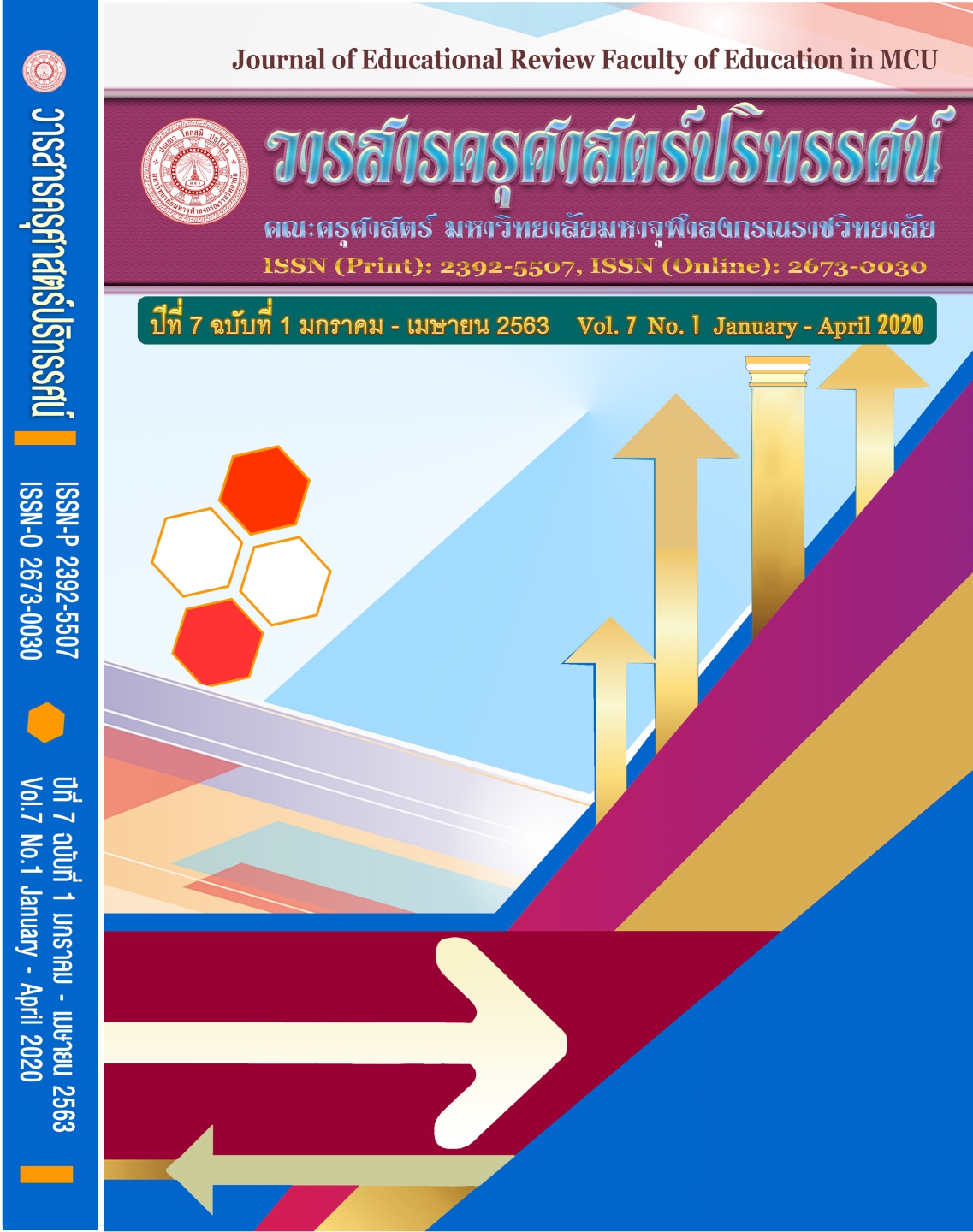DEVELOPMENT OF PALI 9 GRADUATES POTENTIAL IN THE 21 CENTURY
Main Article Content
Abstract
The purposes of this research articles were 1) to study the state of the Pali 9 graduates potential in the 21st century, 2) to study the process of developing the Pali 9 graduates potential in the 21st century, and 3) to examine process of developing the Pali 9 Graduates Potential in the 21 Century. Mixed methods research was used for research design and was designed into three phases. Phase 1 studied the potential condition with the questionnaires and was used by 114 samples. Data were analyzed using descriptive statistics including frequency, percentage, mean and standard deviation. Phase 2 studied the development process with 5 key informants using an interview, and data were analyzed using content analysis. Phase 3 validated the development process with focus group discussion of 8 experts and analyzed by content analysis. Results showed that 1) the state of the Pali 9 Graduates potential and the overall was at a high level in all 5 aspects consisted of 1) knowledge, 2) skills, 3) ability, 4) value, and 5) personal features. When considering the potential in each aspect, it has shown the highest mean to least were personal features, value, ability, skills and knowledge. 2) The process of developing the Pali 9 Graduates Potential has shown 5 parts consisted of Part 1 principle, Part 2 objectives, Part 3 preparation of development divided into 3 steps consisted of before development, during development, and after development. Part 4 development processes consisted of 1) the state of the Pali 9 Graduates potential, 2) Buddhist principles by Iddhipāda IV, 3) process of capacity development in all 5 areas which were essence, objectives, learning management, equipment, activity, development method and evaluation method. Part 5 evaluation of development results using the CIPP technique and concluded knowledge of research to be KSAVPI. 3) The examine process of developing the Pali 9 Graduates potential was divided into 5 parts consisted of principle, objectives, preparation, development process and assessment was appropriateness and usefulness that can be applied to Phra Pariyattidhamma Schools in Pali section with effectively.
Article Details
ทัศนะและความคิดเห็นที่ปรากฏในบทความในวารสารฉบับนี้ถือเป็นความรับผิดชอบของผู้เขียนบทความนั้นเพียงผู้เดียว และไม่ถือเป็นทัศนะและความรับผิดชอบของกองบรรณาธิการ
กองบรรณาธิการขอสงวนสิทธิ์ในการคัดเลือกบทความลงตีพิมพ์และจะแจ้งให้เจ้าของบทความทราบหลังจากผู้ประเมินบทความตรวจอ่านบทความแล้ว
ต้นฉบับที่ได้รับการตีพิมพ์ในวารสารครุศาสตร์ปริทรรศน์ คณะครุศาสตร์ มหาวิทยาลัยมหาจุฬาลงกรณราชวิทยาลัย ถือเป็นกรรมสิทธิ์ของคณะครุศาสตร์ มหาวิทยาลัยมหาจุฬาลงกรณราชวิทยาลัย ห้ามนำข้อความทั้งหมดหรือบางส่วนไปพิมพ์ซ้ำ เว้นเสียแต่ว่าจะได้รับอนุญาตจากมหาวิทยาลัยฯ เป็นลายลักษณ์อักษร
References
กองพุทธศาสนศึกษา สำนักงานพระพุทธศาสนาแห่งชาติ. (2560). เปิดโลกทัศน์การศึกษาพระปริยัติธรรม. นครปฐม: กลุ่มการศึกษาพระปริยัติธรรมแผนกธรรม–บาลี.
แก้วใจ สุวรรณเวช. (2559). การพัฒนารูปแบบการเรียนการสอนเพื่อส่งเสริมสมรรถนะการสอนภูมิศาสตร์ สำหรับนักศึกษาวิชาชีพครูสังคมศึกษา. ฉบับภาษาไทย สาขามนุษยศาสตร์ สังคมศาสตร์และศิลปะ. 9(2).
ธีรวุฒิ ประทุมนพรัตน์ และคณะ. (2531). การบริหารและการนิเทศการศึกษา. สงขลา: เทมการพิมพ์.
พระครูสมุทรประภากร (เฉลิม ปภงฺกโร). (2557). การพัฒนาศักยภาพของพระอุปัชฌาย์ในเขตการปกครองคณะสงฆ์ภาค 15. ดุษฎีนิพนธ์พุทธศาสตรดุษฎีบัณฑิต. มหาวิทยาลัยมหาจุฬาลงกรณราชวิทยาลัย.
พระธรรมปิฎก (ป. อ. ปยุตฺโต). (2538). อนุสรณ์พระธรรมทูตสายต่างประเทศ รุ่นที่ 1. กรุงเทพมหานคร: โรงพิมพ์มหาจุฬาลงกรณราชวิทยาลัย.
พระมงคลสุตาคม (สิทธิชัย อติธมฺโม). (2560). การบริหารการศึกษาคณะสงฆ์. กรุงเทพมหานคร: โรงพิมพ์ มหาจุฬาลงกรณราชวิทยาลัย.
พระมหาศุภกิจ สุภกิจฺโจ. (2558). กลยุทธ์การพัฒนาทรัพยากรมนุษย์ของสำนักงานส่งเสริมการศึกษานอกระบบและการศึกษาตามอัธยาศัย กรุงเทพมหานคร. ดุษฎีนิพนธ์พุทธศาสตรดุษฎีบัณฑิต. มหาวิทยาลัยมหาจุฬาลงกรณราชวิทยาลัย.
พระเมธีธรรมาภรณ์ (ประยูร ธมฺมจิตฺโต). (2538). อนุสรณ์พระธรรมทูตสายต่างประเทศ รุ่นที่ 1. กรุงเทพมหานคร: โรงพิมพ์มหาจุฬาลงกรณราชวิทยาลัย.
พะยอม วงศ์สารศรี. (2528) องค์กรและการจัดการ. กรุงเทพมหานคร: มูลนิธิโกมลคีมทอง.
ไพฑูลย์ สินลารัตน์. (2557). ทักษะแห่งศตวรรษที่ 21 ต้องก้าวให้พ้นกับดักของตะวันตก. กรุงเทพมหานคร: วิทยาลัยครุศาสตร์ มหาวิทยาลัยธุรกิจบัณฑิตย์.
วิจารณ์ พานิช. (2555). วิถีสร้างการเรียนรู้เพื่อศิษย์ในศตวรรษที่ 21. กรุงเทพมหานคร: มูลนิธิสดศรี-สฤษดิ์วงศ์.
สมใจ ธีรทิฏ. (2556). กลยุทธ์การพัฒนาผู้เรียนให้มีคุณลักษณะพลเมืองอาเซียนที่พึงประสงค์. ดุษฎีนิพนธ์การศึกษาดุษฎีบัณฑิต. มหาวิทยาลัยศรีนครินทรวิโรฒ.
สมศักดิ์ บุญปู่. (2554). พระสงฆ์กับการศึกษาไทย. พิมพ์ครั้งที่ 3. กรุงเทพมหานคร: โรงพิมพ์มหาจุฬาลงกรณราชวิทยาลัย.
สำนักงานเลขาธิการสภาการศึกษา. (2547). การพัฒนาองค์กรและบุคลากรแนวคิดใหม่ในการพัฒนาทรัพยากรบุคคล. กรุงเทพมหานคร: 21 เซ็นจูรี่.
สุนันทา เลาหนันทน์. (2544). การพัฒนาองค์การ. กรุงเทพมหานคร: ดีดีบุคสโตร์.
Nick, Wilton. (2013). An introduction to Human Resource Management. London: SAGE.
Organisation for Economic Cooperation and Development (OECD). (2008). 21st Century Learning: Research Innovation and Policy Directions from recent OECD analyses. Paper presented at the OECD/ CERI International Conference “Learning in the 21st. Century: Research. Innovation and Policy.
Casner-Lotto, J., & Barrington, L. (2006). Are They Really Ready to Work? Employers' Perspectives on the Basic knowledge and Applied Skills of New Entrants to the 21st Century. U.S. Workforce: ERIC.


